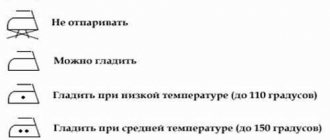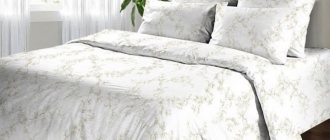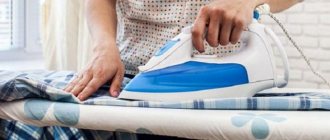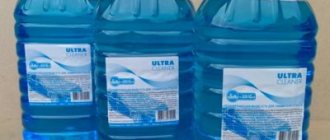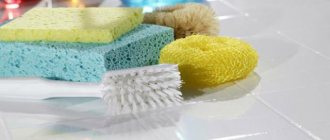Among the variety of household appliances, it is sometimes difficult to determine how the devices differ from each other.
There are several devices that generate steam, but at the same time perform different functions.
The question often arises about what is better: a steamer or a steam generator. There is no definite answer - both devices have their pros and cons.
In some conditions, priority is given to steam generators, and in others, to the steamer. When and how best to use a particular device should be analyzed comprehensively.
Page navigation:
How the steamer works
The steamer is designed for contactless ironing of laundry by exposing it to hot water steam. The working sole does not touch the fabric. Steam, penetrating into the structure of the fibers of the material, returns volume and smoothness to them, moisturizes and straightens them, smoothing the product from wrinkles, creases and folds.
Technically, the steamer consists of the following key components:
- water container;
- a heating element;
- clothes rack;
- steam hose for supplying steam from the tank to the release point;
- iron (steam release point, working surface).
Design of a vertical clothing steamer
The water tank is often a removable structure. Before starting work, it must be filled with water. The instructions for a specific model indicate which water is suitable for it. The container is inserted into the body of the device, where the water is heated using a heating element. Hot steam accumulates, builds pressure, and then flows through the hose to the iron. The sole of the iron has many holes for steam to escape, through which steam is supplied to the fabric. The steam temperature can be 100 degrees or higher.
Working with a steamer has a number of advantages.
- Ironing occurs without contact of the sole with the fabric, without pressure, displacement and other mechanical actions.
- Steam straightens the fabric fibers, restoring their volume.
- Suitable for all types of fabrics: from thin and delicate to heavy and dense. It also copes well with the care (ironing and cleaning) of clothes with a complex cut (folds, pleats, multi-layering).
- Vertical steaming: thanks to the long hose, curtains can be steamed without removing them from the curtain rod at any height.
- You can take care of things right on the spot; for example, curtains can be cleaned, refreshed and ironed without removing them from the curtain rod.
- Quick preparation for work (steam is ready in less than 1 minute).
Common features
It’s easy to guess that the operating principle of all devices is based on the supply of steam. This is true. Steam is used in all appliances for a number of reasons:
- The steam has a temperature of about 130°, so it easily destroys most microorganisms, moth larvae, mites and mold that collect in the weaves of fabric threads and folds.
- The steam flow also helps in removing stains - it moistens the dust and softens the dirt, after which it is effectively removed with a brush. An additional advantage is that there is no need to use chemicals that are harmful to health.
- It also removes unpleasant odors, which is especially important for pet owners.
Otherwise, the operating principle and, accordingly, the use of steamers, steam cleaners and steam generators still differ, so it is best to focus on each device separately.
How does a steam generator work?
The steam generator is structurally close to a classic iron with a steam function, the only difference being that the water capacity of the steam generator is much larger, and it is possible to use the steam discharge constantly. The steam temperature is 120-160 degrees, the pressure can reach 6 bar. The combination of pressure, humidity and high temperature allows the steam to process the fabric to its full depth, affecting every fiber. Such a device can easily cope even with heavy fabrics or linen folded in several layers.
The steam generator includes the following components.
- A boiler consisting of a water tank and a heating element. The container can be removable or built into the device body.
- Steam hose.
- Iron and/or additional attachments.
Design of an iron with a steam generator
The water in the boiler boils, the released steam accumulates and creates a certain pressure. The user starts working and by pressing a certain key supplies steam through the hose to the iron. The soleplate of the iron has holes for steam to escape. Through them, steam under high pressure goes to the tissues.
Read more: the structure and principle of operation of the steam generator.
Advantages of steam generators:
- steam has a high temperature, so ironing is quick and easy;
- cope with thick, very heavy or voluminous fabrics due to the deep penetration of steam into the fabric (steam boost);
- this device can be used as a traditional iron or as a contactless steamer;
- there is an aggressive steam boost for heavy fabrics and moderate constant steam exposure for delicate fabrics;
- a large volume of water allows you to work for a long time without refueling;
- hot steam disinfects.
Pros and cons of a steamer
Advantages of the device:
- Wet steam gently treats fabrics without squeezing the fibers.
- The product gains volume.
- You can process different types of things (fur, lint).
- The telescopic handle allows you to use the device vertically while suspended.
- The model is ideal for home cleaning.
Disadvantages: low intensity of operations, average disinfection efficiency. The device will not replace the iron.
Steaming is simple and quick, but not all things
Main differences between the devices
Despite similar designs and applications, these devices are very different from each other.
- The steamer works with wet steam at a temperature of about 100 degrees and low pressure. The steam generator acts on materials with dry hot steam (up to 160 degrees) under high pressure.
- The steamer reaches operating parameters almost instantly (up to 1 minute). The steam generator takes more time to gain pressure and temperature; on average, it takes 2-3 minutes to prepare for operation, and with a large volume of water, up to 10 minutes.
- The steam supply from the steamer occurs at a speed of 30-60 ml per minute, and from the steam generator it is about 100 ml/min (up to 150 ml/min).
- The steamer works contactless (the working nozzle often looks like a brush or frame), the steam generator's effect on fabric is close to a classic iron, and here the quality of the sole is of great importance.
- The steamer is used for vertical steaming, and the steam generator is used for working on a horizontal surface, although some models support the vertical steaming function (but this is inconvenient to do due to the significant weight of the iron).
Both devices are quite large and take up a lot of storage space. Only the steamer looks like a vacuum cleaner with a stand, and you need to look for a place for it on the floor. And the steam generator looks like an iron on a massive stand, and it is more convenient to store it on the table.
conclusions
Based on the results of the analysis of the design and operation of steam generators and steamers, certain conclusions can be drawn:
- It is impossible to answer the question which device is better - they have different purposes .
- Steam generators provide dry steam ironing at elevated temperatures and are well suited for coarse and multi-layered materials .
- Steamers provide wet steam and contactless ironing. This ensures high-quality work with delicate fabrics, and can also be used for cleaning and housekeeping.
- Steamers are used effectively in a vertical position. And steam generators are designed for operation in a horizontal position.
- When choosing devices, you should carefully familiarize yourself with its functionality and technical characteristics.
In fact, both devices cannot be called universal.
They have their own specific application, and therefore, if possible, it is better to have both a steam generator and a steamer at home.
When to choose a steam generator
It is necessary to choose a steam generator if:
- you often iron a lot of clothes;
- it needs to be done very quickly;
- you have to work with delicate fabrics: synthetics, silk, etc.
When choosing a steam generator, you need to understand its essence and specifics of operation. In fact, it differs in that the steam is generated in a separate device in a special container, and then supplied through a tube. Things smooth out much better with minimal effort and loss of time. Compared to a classic iron, the steam generator produces almost 4 times more steam. This is the optimal solution for any fabric. Thanks to the high pressure, the steam penetrates very quickly and deeply into the fabric, due to which even the densest fabrics are smoothed.
With the help of a steam generator, you can quickly deal with a large amount of laundry, since you can iron it by folding it in several layers.
You can choose any modern unit that suits your wallet and tasks. This has become available thanks to a large number of models from different manufacturers.
What is better to buy: a steamer or a steam generator
It can be difficult to determine what to buy: a clothes steamer or a steam generator. It is impossible to say unequivocally that one solution is better than another, since each solves certain problems. The steamer not only smoothes fabrics, but also cleans surfaces, so it is suitable for cleaning. The generator can only be used for ironing.
It is better to use a vertical steamer rather than a steam generator in the following cases:
- you need to constantly iron things of non-standard styles with decorative inserts;
- there is a need to quickly refresh fabric products, remove dust and unpleasant odors;
- there is a need to process a significant number of things;
- I want to speed up the process of regular cleaning.
A generator is the best choice if:
- it is necessary not only to iron, but also to disinfect;
- There is a desire to speed up the clothing processing process.
Products are not universal, each has its own characteristics, strengths and weaknesses, and solves assigned problems. Effective ironing and cleaning are practically incompatible concepts; it would be better to spend more and purchase two units at once.
What to choose is often a question of the tasks to be solved
Steam cleaner
Steam cleaners are available in three quite different types.
The first type is lightweight hand-held steam cleaners. They are similar to steamers, but differ in larger container volume, greater power and the shape of the nozzle, which is usually a cone with a thin spout. This form was not chosen by chance, since the device is not used for ironing, but for cleaning and disinfection in hard-to-reach places, for example, in the folds of upholstered furniture, in the car interior, in the toilet and bathroom, in the kitchen.
A more powerful steam stream effectively fights dirt, disinfects surfaces and penetrates even into narrow cracks and joints, and also removes unpleasant odors well.
There is only one drawback in this case - the dirt and dust themselves do not “evaporate” anywhere, so cleaning using a steam cleaner should always be completed by wiping the treated smooth surfaces with microfiber and cleaning carpets and upholstered furniture with a vacuum cleaner, which collects softened dirt and wet, sticky fine dust. This type of cleaning takes longer, but the results are more noticeable. Moreover, for people suffering from allergies, it becomes a real salvation, as it allows you to eliminate the smallest particles of pollen and hair.
The second type is steam mops. Their specialization is quite narrow - they are used exclusively for washing and disinfecting floors. It is very interesting that this particular type of steam cleaner was one of the first to appear, only later turning into devices for caring for clothes.
And finally, the third type is steam vacuum cleaners. The main function that distinguishes them from all other devices is powerful suction and collection of steam-cleaned dust and dirt. Steam vacuum cleaners can be considered the most effective and convenient devices for cleaning, since it does not need to be done in several stages, but they are also the most expensive.

